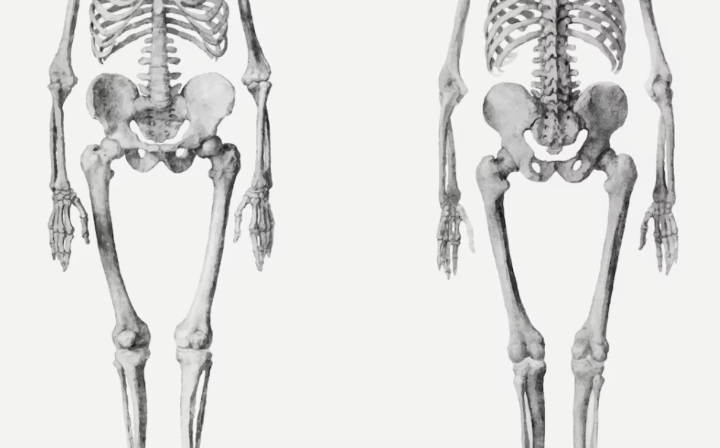The Sacroiliac Joint (SIJ), located at the base of the spine and connecting the spine to the hips, is vital in supporting the body’s weight and movement. Despite its importance, it remains a relatively less understood part of our anatomy. Often, pain experienced in the lower back or hips can be attributed to issues within the SIJ. However, diagnosing and treating SIJ problems can be challenging due to the complexity of the joint and its proximity to other structures that can cause similar symptoms.
You need to understand the anatomy, structure and position of the sacroiliac joint in order to properly evaluate and diagnose any pain or dysfunction related to it.
This joint is a bony articulation between the sacrum and ilium bones of the pelvis. It is supported by strong ligaments, including two large ligaments – the anterior and posterior sacroiliac ligaments – that attach from one side of the joint to the other.
The SIJ has a small surface area with an articular capsule surrounding it for stability. This allows for minimal mobility at this joint, which helps protect it from injury during normal activities like walking, running, or lifting heavy objects.
Pain is typically caused by strain in this area, on these supporting structures, or irritation of the joint surface itself. Understanding how this joint functions will help medical professionals more accurately diagnose any issues with it.
The main purpose of your SIJ is to provide stability and absorb shock. This joint plays a vital role in the body as it helps transfer forces between the upper and lower body, such as when walking or running.
It also aids in the movement of the hips, pelvis, and lumbar spine. The following are some other functions of the SIJ:
Pain in the lower back can often be attributed to SIJ. This joint connects your lower spine to your pelvis and transfers pain along your upper body and legs. Sometimes the discomfort is a simple axial low back pain as well. Si joint Dysfunction can cause pain that may radiate into the buttocks, thighs, and feet.

Photo Credit: rawpixel, Freepik
Common causes of pain in the SIJ include sacroiliitis, which is a form of arthritis that affects the joint; spondylolisthesis, which is when one vertebra slips forward over another; and hypermobility in the joint caused by lax ligaments. In addition, injury or trauma to the area may cause inflammation or swelling, which raises suspicion of sacroiliac joint dysfunction emanating within the joint.
It’s important to identify any underlying causes of pain in the SIJ to treat it effectively.
To identify the source of your lower back discomfort, it’s important to diagnose any possible SIJ issues.
Diagnosing an SIJ problem can involve:
By accurately diagnosing your pain in the SIJ, you can better understand its cause and develop an effective treatment plan. Left untreated it can lead to pain across the joint
Finding relief from lower back pain can be complex, but a variety of treatments can help manage SIJ discomfort. The sacroiliac joint (SIJ) is located between the sacrum and the ilium in the pelvis. When this joint becomes inflamed or injured, it can cause significant pain.

Photo Credit: fxquadro, Freepik
Options of Treatment for pain in the SIJ depend on its severity and underlying cause. Generally, nonsteroidal anti-inflammatory drugs (NSAIDs) may be prescribed to reduce inflammation and relieve pain; physical therapy exercises are also commonly used to strengthen and stabilize the area. In more severe cases, corticosteroid injections or surgery may be necessary to alleviate pain.
For some injections into the sacroiliac joint to alleviate stress to the SI joint is the best course of action. So, it’s important to consult a doctor if persistent SI joint pain persists, so they can help you determine the most effective treatment option for pain relief depending on your situation.
You can take steps to prevent SIJ discomfort and promote joint health. To begin, it’s important to understand the anatomy of the sacroiliac joint (SIJ). The long dorsal sacroiliac ligament provides stability between the spine and pelvis and helps control movement in this area.
Practising good posture can help reduce strain on the SIJ and associated pelvic pain. Additionally, regular exercise that strengthens core muscles is beneficial for the overall support of the SIJ.
Finally, avoiding activities that stress the lower back, such as running or lifting heavy objects, can help prevent pain in the SIJ. By following these tips, you can ensure the healthy functioning of your sacroiliac joint and avoid any potential issues.
Some exercises that can help with Sacroiliac Joint (SIJ) pain:
As with any exercise regimen, it’s crucial to consult with a healthcare professional or physical therapist before starting these exercises to ensure they are appropriate for your specific situation. Always perform exercises in a controlled manner, focusing on proper form to avoid injury.
Alternative therapies can offer much-needed relief and improved mobility for those suffering from pain in the sacroiliac joint. From yoga to chiropractic care, various treatments are available to target the source of pain.

Photo Credit: Freepik
Here are three alternative therapies for sacroiliac joint dysfunction:
These are just some of the many alternative treatments that relieve SIJ-related discomfort and improve your overall quality of life.
Pain in the Sacroiliac joint can manifest as a sharp, stabbing, or dull ache in the lower back, region near the hip joint or pain in the buttocks area. The pain can sometimes radiate down the legs, mimicking sciatica.
Pain in the Sacroiliac joint can be triggered by various factors, including prolonged sitting or standing, bending, lifting, running, or climbing stairs. Certain conditions like pregnancy, gait issues, arthritis, or injury can also lead to SI joint pain.
The five common tests for diagnosing sacroiliac joint dysfunction are:
Each test involves different positions or movements to provoke SI joint pain and assess its source.
Pain in the Sacroiliac joint refers to pain that originates from the sacroiliac joint, which is the joint connecting the sacrum (lower part of the spine) to the pelvis. This type of pain is also known as sacroiliac joint dysfunction or sacroiliitis.
The symptoms of pain in the Sacroiliac joint may include pain in the low back, pain in the hips or buttocks, leg pain, and pain that may radiate down to the thighs. Common causes of pain in the sacroiliac joint include trauma or injury, pregnancy, degenerative joint disease, and joint inflammation.
The sacroiliac joint is a synovial joint, which means it has a joint capsule that surrounds and protects it. Several ligaments, including the interosseous sacroiliac ligament support the joint. The movements of the sacroiliac joints are minimal but allow for slight rotation and tilting of the pelvis.
Diagnosis of sacroiliac joint dysfunction can be challenging because the symptoms overlap with other conditions. However, a thorough physical examination, medical history review, and imaging tests such as X-rays, MRI, or CT scans can help diagnose accurately.
Pain in the Sacroiliac joint can originate from various sources, including the ligaments of the sacroiliac joint, inflammation of the joint, degenerative changes in the joint, and dysfunction in the sacroiliac joint due to various factors such as trauma, pregnancy, or repetitive stress on the joint.
Treatment for sacroiliac joint dysfunction may include non-surgical options such as physical therapy, pain medications, sacroiliac joint injections, or wearing a sacroiliac joint belt for added support. Surgery may sometimes be recommended to stabilize the joint or address any underlying conditions causing the pain.
Yes, patients with low back pain often show signs of pain in the sacroiliac joint. The pain may radiate from the lower back to the buttocks, hips, and thighs. However, it’s important to note that not all low back pain is caused by sacroiliac joint dysfunction, and a healthcare professional should make a proper diagnosis.